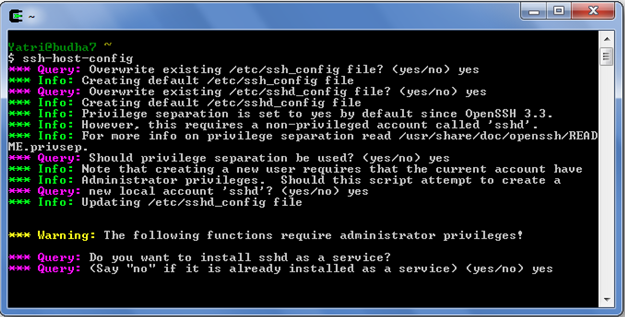


SSH KEYGEN WINDOWS COMMAND LINE DOWNLOAD
Download pageant.exe, puttygen.exe, putty.exe and plink.exe from PuTTY's website.All answers here were too short, so I'll post a detailed guide here: The most efficient way is using Pageant because it will let you write the passphrase only once at the beginning of the session instead of every push. On the GitHub website, go to 'Account settings', 'SSH and GPG keys', click 'New SSH key', and paste the key.In Git Bash, type 'cat ~/.ssh/id_rsa.pub', select the result, and copy it to the clipboard.If it lists the files in your home directory on the Git server, and then you're done!įor GitHub, you don't have shell access to their server, but you can upload the key using their website, so for the bit 'now copy to your server', do: That's it! You're done! From Git Bash, do the following to test: ssh ls Now ssh into the destination server, then do mkdir -p ~/.ssh Scp ~/.ssh/id_rsa.pub the bit on your own computer done. Now copy the public key to your server, for example:.

(so just press 'enter' to all questions') It is actually fairly simple, if you know what to type. None of the previous answers worked for me. You need to do that for every repository you are using TortoiseGit with. When using TortoiseGit, you need to set the SSH key via pacey's directions. You may need to copy the OpenSSH key to Program Files\Git\.ssh\id_rsa (or Program Files (x86)\Git\.ssh\id_rsa). Note: Comments indicate that this doesn't work in all cases. After you have the key at that location, Git Bash will recognize the key and use it. Once your key is open, you want to select Conversions -> Export OpenSSH key and save it to HOME\.ssh\id_rsa. ssh folder under that, you want to open PuTTYgen and open the key (.ppk file) you have previously created. ssh.Īfter you have the home directory, and a. While you're in Git Bash, you should mkdir. If you are running msysgit (I am assuming you are) and are looking to run Git Bash (I recommend it over TortoiseGit, but I lean to the CLI more than GUI now), you need to figure out what your home directory is for Git Bash by starting it then type pwd (On Windows 7, it will be something like C:\Users\phsr I think).


 0 kommentar(er)
0 kommentar(er)
